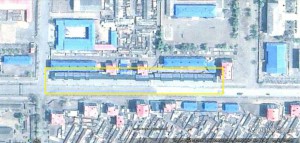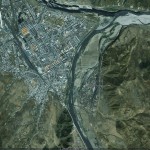According to the Choson Ilbo:
The senior secretaries of all North Korea’s 11 metropolitan and provincial party committees paid a rare collective visit to a senior member of the Communist Party of China in Beijing on Tuesday.
The North Korean delegation led by Mun Kyong-dok, the senior secretary of the Pyongyang municipal party committee, met with Zhou Yongkang, a member of the Politburo Standing Committee who ranks ninth in the hierarchy, to discuss economic cooperation.
Zhou was quoted by the official Xinhua news agency as saying it was “the first time” in the history of bilateral relations that senior secretaries of the Workers Party’s metropolitan and provincial committees have visited China as a group. “I wish that you will expand exchange with various Chinese regions you’re visiting and achieve success from your tours.”
The North Koreans also met with their Chinese counterparts to discuss investment in development projects in the North. The Chinese officials were in Beijing to attend the fifth plenary session of the 17th Communist Party Central Committee.
A South Korean government official said, “The North Korean officials’ visit to Beijing is equivalent to all 16 South Korean metropolitan mayors and provincial governors flying to Washington as a group to discuss exchange and cooperation with ruling-party lawmakers and state governors in the U.S.” He said since Kim Jong-il’s son Jong-un was established as the official successor to the leadership, the North and China have increased the frequency of personnel exchanges “to discuss more substantive matters than before.”
The profiles of the Chinese delegation that attended the 65th anniversary celebrations of the North Korean Workers Party were also exceptional. It included senior officials of the three Chinese northeastern provinces — Sun Zhengcai, the secretary of the Jilin provincial party committee, Chen Xi, the deputy secretary of the Liaoning provincial party committee, and Du Yuxin, the deputy secretary of the Heilongjiang provincial party committee.
They were welcomed at Sunan Airport by Ju Yong-sik, the senior secretary of the party committee in Jagang Province, a border region. The senior secretaries of the party committees in all four North Korean provinces bordering China — Ju from Jagang Province, Ri Man-gon from North Pyongan Province, O Su-yong from North Hamgyong Province and Kim Hi-taek from Yanggang Province — attended a dinner that evening in honor of the Chinese delegation.
“There have recently been more signs of the North and China deepening and developing economic cooperation, including various development projects focusing on the border areas,” a Unification Ministry official said. “It seems that after the North’s Workers Party and the Chinese Communist Party finished talks at headquarters level, their provincial party committees have now begun concrete cooperation.”
Military exchanges are also increasing ahead of the 60th anniversary of the day the Chinese joined the Korean War on Oct. 25.
The official North Korean Central Broadcasting Station on Tuesday reported a delegation of Chinese People’s Volunteer Veterans led by Wang Hai, a former Air Force commander, and the People’s Liberation Army’s art troupe arrived in Pyongyang for the anniversary.
O Kuk-ryol, vice chairman of the National Defense Commission, and Pak Jae-kyong, vice minister of People’s Armed Forces, hosted a reception for them.
On Oct. 14, a North Korean Army delegation led by Pyon In-son, another vice minister of People’s Armed Forces, visited China, to tour PLA units. Quoting the North’s official Rodong Sinmun daily, Xinhua said, “Friendship bonded by blood in the previous generations is being handed down to the next generation.”
A South Korean security official said, “The North is apparently trying to counter the South Korea-U.S. military alliance, which has been strengthened since the sinking of the Navy corvette Cheonan in March, by intensifying military ties with China, as well as attempting to escape international economic isolation by leaning on China.”
Mike has more at NK Leadership Watch.
Read the full story here:
N.Korea, China Grow Ever Closer
Choson Ilbo
10/21/2010



